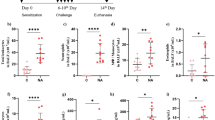Abstract
To investigate the mechanism by which azelastine may be effective therapeutically in asthma, we studied its ability to inhibit anti-IgE- and calcium ionophore A23187-stimulated histamine release from human lung and to alter lung cyclic nucleotide levels. Significant inhibition of histamine release from both anti-IgE- and A23187-stimulated human tissue was aparent after 30 minutes preincubation of the lung tissue in azelastine. Significant inhibition of anti-IgE-stimulated histamine release was consistently seen in azelastine concentrations ≥5 μM, and was dose dependent (r=0.71,p<0.05) with maximal mean inhibition of 53±11%. For A23187-stimulated lung tissue, consistent inhibition of histamine release was not found until we used 30 μM azelastine, mean 35±11%. Inhibition in azelastine concentrations below 30 μM was variable and not significant. Lung cyclic AMP and cyclic GMP content was not significantly altered by incubation of lung tissue in 100 μM azelastine. We conclude that azelastine inhibits stimulated histamine release from human lung tissuein vitro but does not alter cyclic nucleotide content.
Similar content being viewed by others
References
W. Storms, E. Middleton, D. Dvorin, J. Kemp, S. Spector, J. Newton and J. L. Perhach,Azelastine (Azel) in the treatment of asthma. J. Allergy Clin. Immunol.75, 167 (1985).
S. Motojima, Y. Ohashi, T. Otsuka, T. Fukuda and S. Makino,Effects of azelastine on allergen and exercise-induced asthma. Asian Pac. J. Allergy3, 174–178 (1985).
S. Ollier, C. A. L. Gould and R. J. Davies,The effect of single and multiple dose therapy with azelastine on the immediate asthmatic response to allergen provocation testing. J. Allergy Clin. Immunol.78, 358–364 (1986).
H. J. Zechel, N. Brock, D. Lenke and U. Achterath-Tuckermann.Pharmacological and toxicological properties of azelastine, a novel antiallergic agent. Arzneim Forsch.31, 1184–1193 (1981).
K. Tasaka and M. Akagi,Antiallergic properties of a new histamine antagonist, 5-(p-chlorobenzyl)-2-[N-methyl-perhydroazepinyl-(4)]-1-(2H)-phthalazinone hydrochloride (azelastine). Arzneim Forsch.29, 488–493 (1979).
P. Atkins, H. Merton, P. Karpink, I. Weliky and B. Zweiman,Azelastine inhibition of skin test reactivity in humans.J. Allergy Clin. Immunol. 75, 167 (1985).
S. Katayama, N. Akimoto, H. Shionoya, T. Morimoto and Y. Katoh,Antiallergic effect of azelastine hydrochloride on immediate type hypersensitivity rections in vivo and in vitro. Arzneim Forsch.31, 1196–1202 (1981).
B. Fischer and W. Schmutzler,Inhibition by azelastine of the immunologically induced histamine release from isolated guinea pig mast cells. Arzneim Forsch.31, 1193–1195 (1981).
N. Chand, J. Pillar, W. Diamantis and R. D. Sofia,Inhibition of IgE-mediated allergic histamine release from rat peritoneal mast cells by azelastine and selected antiallergic drugs. Agents and Actions16, 318–322 (1985).
N. Chand, J. Pillar, W. Diamantis, J. L. Perhach Jr. and R. D. Sofia,Inhibition of calcium ionophore (A23187)-stimulated histamine release from rat peritoneal mast cells by azelatine: implications for its mode of action. Eur. J. Pharmacol.96, 227–233 (1983).
D. A. S. Fields, J. Pillar, W. Diamantis, J. L. Perhach Jr., R. D. Sofia and N. Chand,Inhibition by azelastine of nonallergic histamine release from rat peritoneal mast cells. J. Allergy Clin. Immunol.73, 400–403 (1984).
N. Chand, J. Pillar, W. Diamantis and R. D. Sofia,Inhibition of allergic histamine release by azelastine and selected antiallergic drugs from rabbit leukocytes. Int. Arch. Allergy Appl. Immunol.77, 451–455 (1985).
J. P. Kemp, E. O. Meltzer, H. A. Orgel, M. J. Welch, G. A. Bucholtz, E. Middleton, S. L. Spector, J. J. Newton and J. L. Perhach Jr.,A dose-response study of the bronchodilator action of azelastine in asthma.J. Allergy Clin. Immunol. 79, 893–899 (1987).
R. P. Siraganian,An automated continuous-flow system for the extraction and fluorometric analysis of histamine. Anal. Biochem.57, 383–394 (1974).
L. F. Platshon and M. Kaliner,The effects of the immunological release of histamine upon human lung cyclic nucleotide levels and prostaglandin generation. J. Clin. Invest62, 1113–1121 (1978).
T. B. Casale, D. Rodbard and M. Kaliner,Characterization of histamine H-1 receptors on human peripheral lung. Biochem. Pharmacol.34, 3285–3292 (1985).
M. Kaliner,Human lung tissue and anphylaxis. I. The role of cyclic GMP as a modulator of the immunologically induced secretory process. J. Allergy Clin. Immunol.60, 204–211 (1977).
R. R. Fiscus, T. J. Torphy, S. E. Mayer,Cyclic GMP-depen-dent protein kinase activation in canine tracheal smooth muscle by methacholine and sodium nitroprusside. Biochimica et Biophysica Acta805, 382–392 (1984).
T. B. Casale, D. Wood, S. Wescott and M. Kaliner,Immunohistochemical identification of lung cells responsive to β-stimulation with rise in cAMP. J. Appl. Physiol.63, 434–439 (1987).
O. H. Lowry, N. J. Rosebrough, A. L. Farr and R. J. Randall,Protein measurement with the folin phenol reagent. J. Biol. Chem.193, 265–275 (1951).
L. M. Lichtenstein and S. Margolis,Histamine release in vitro: inhibition by catecholamines and methylxanthines. Science (Washington),161, 902–903 (1968).
R. P. Orange, W. G. Austen and K. F. Austen,Immunological release of histamine and slow-reacting substance of anaphylaxis from human lung. J. Exp. Med.134, 136s-148s (1971).
R. P. Orange, M. A. Kaliner, P. J. Laraia and K. F. Austen,Immunological release of histamine and slow-reacting substance of anaphylaxis from human lung. II. Influence of cellular levels of cyclic AMP. Fed. Proc.30, 1725–1729 (1971).
I. Mota and W. D. DaSilva,The anti-anaphylactic and histamine-releasing properties of the antihistamines. Their effect on the mast cells. Br. J. Pharmacol.15, 396–404 (1960).
L. M. Lichtenstein and E. Gillespie,The effects of the H 1 and H 2 antihistamines on “allergic” histamine release and its inhibition by histamine. J. Pharmacol. Exp. Ther.192, 441–450 (1975).
M. K. Church and C. F. Gradidge,Inhibition of histamine release from human lung in vitro by antihistamines and related drugs. Br. J. Pharmacol.69, 663–667 (1980).
K. Tatsumi, O. U. Toshio, H. Yamada and H. Yoshimura,Studies on metabolic fate of a new antiallergic agent, azelastin (4-(p-chlorobenzyl)-z-[N-methylperhydroazepinyl-(4)]-1-(2H)-phthalazinone hydrochloride. Jpn. J. Pharmacol.30, 37–48 (1980).
Author information
Authors and Affiliations
Additional information
Supported in part by a VA Merit Review Award and a grant from Wallace Laboratories, Division of Carter-Wallace.
Rights and permissions
About this article
Cite this article
Little, M.M., Wood, D.R. & Casale, T.B. Azelastine inhibits stimulated histamine release from human lung tissuein vitro but does not alter cyclic nucleotide content. Agents and Actions 28, 16–21 (1989). https://doi.org/10.1007/BF02022975
Received:
Accepted:
Issue Date:
DOI: https://doi.org/10.1007/BF02022975




